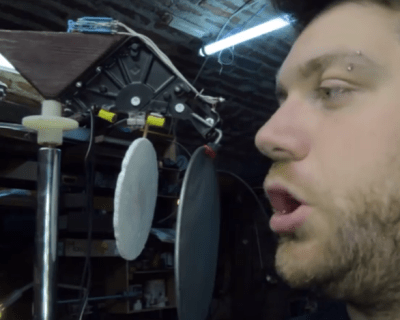[Rulof Maker] has a penchant for making nifty projects out of old electronics. The one that has caught our eye is a microphone made from parts of an old hard drive. The drive’s arm and magnet were set aside while the aluminum base was diagonally cut into two pieces. One piece was later used to reassemble the hard drive’s magnet and arm onto a wooden platform.
 The drive’s arm and voice coil actuator are the key parts of this project. It was modified with a metal extension so that a paper cone cut from an audio speaker could be attached, an idea used in microphone projects we’ve previously featured. Copper wire scavenged from the speaker was then soldered to voice coil on the arm as well as an audio jack. In the first version of the Hard Drive Microphone, the arm is held upright with a pair of springs and vibrates when the cone catches sound.
The drive’s arm and voice coil actuator are the key parts of this project. It was modified with a metal extension so that a paper cone cut from an audio speaker could be attached, an idea used in microphone projects we’ve previously featured. Copper wire scavenged from the speaker was then soldered to voice coil on the arm as well as an audio jack. In the first version of the Hard Drive Microphone, the arm is held upright with a pair of springs and vibrates when the cone catches sound.
While the microphone worked, [Rulof] saw room for improvement. In the second version, he replaced the mechanical springs with magnets to keep the arm aloft. One pair was glued to the sides of the base, while another pair recovered from an old optical drive was affixed to the arm. He fabricated a larger paper cone and added a pop filter made out of pantyhose for good measure. The higher sound quality is definitely noticeable. If you are interested in more of [Rulof’s] projects, check out his YouTube channel.
First Version:
Second Version:

















Quiet an improvement, really nice.
As next project I would suggest, using openCV for a gesture to speech translator, for non italian people…
Just make a microphone out of a speaker. But that would be as much hacking I guess.
*wouldn’t
This might be the first time I’ve ever seen someone use the voice-coil from a hard drive as an actual voice coil!
the sound quality is poor
i will prefer to try make cd drive auto-focus mechanism as microphone
I use the spin up noise for post production sci-fi foley
[quote]Foley is the reproduction of everyday sound effects that are added to film, video, and other media in post-production to enhance audio quality.[1] These reproduced sounds can be anything from the swishing of clothing and footsteps to squeaky doors and breaking glass. The best Foley art is so well integrated into a film that it goes unnoticed by the audience.[2] It helps to create a sense of reality within a scene. Without these crucial background noises, movies feel unnaturally quiet and uncomfortable.
Foley artists recreate the realistic ambient sounds that the film portrays. The props and sets of a film often do not react the same way acoustically as their real life counterparts.[2] Foley sounds are used to enhance the auditory experience of the movie. Foley can also be used to cover up unwanted sounds captured on the set of a movie during filming, such as overflying airplanes or passing traffic.[2]
The term “Foley” also means a place, such as Foley-stage or Foley-studio, where the Foley process takes place.[/quote]